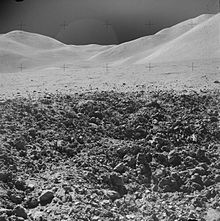To: coloradan; Ultra Sonic 007
The backdrops were apparently considered reusable, even though no Apollo mission visited any of the previously-visited Apollo sites.
was easier to do that that everything involved with actually successfully landing six times in a row without a major failure:


62 posted on
04/15/2017 8:49:03 AM PDT by
rx
(Truth Will Out!)
To: rx
The "reused backgrounds" objection is also answered (at least as regards Apollo 15, but I imagine a similar argument holds for Apollo 17):
xxxx
There are issues with Apollo 15 photos having identical backgrounds.

AS15-82-11057: View of
Apollo 15 Lunar Module from the nearby
ALSEP site (Station 8) during the third
EVA.
[27]

AS15-82-11082: Later photo with same hills in the background near
Hadley Rille (Station 9) during the third EVA, approximately 1.4 km west of the Lunar Module.
[27]
-
- Detailed comparison of the backgrounds said to be identical in fact show significant changes in the relative positions of the hills that are consistent with the claimed locations that the images were taken from. Parallax effects clearly demonstrate that the images were taken from widely different locations around the landing sites.
-
- Claims that the appearance of the background is identical while the foreground changes (for example, from a boulder strewn crater to the Lunar Module) are trivially explained when the images were taken from nearby locations, akin to seeing distant mountains appearing the same on Earth from locations that are hundreds of feet apart showing different foreground items.
-
- Furthermore, as there is only an extremely tenuous atmosphere on the Moon, very distant objects will appear clearer and closer to the human eye. What appears as nearby hills in some photographs, are actually mountains several kilometers high and some 10–20 kilometers away. Changes in such very distant backgrounds are quite subtle, and can be mistaken for no change at all.
-
- As the Moon is also much smaller than the Earth, the horizon is significantly nearer in photographs than Earthbound observers are used to seeing (an eye 1.7 m above completely flat ground will see the horizon 4.7 km away on Earth, but only 2.4 km away on the Moon). This can lead to confusing interpretations of the images.[28]
-
- One specific case is debunked in "Who Mourns For Apollo?" by Mike Bara.[29]
-
-
- While it is true that there is no haze to assist in judging distance, the maximum distance to the horizon is much closer than on Earth, due to the smaller size of the Moon. This limits the scope for the same objects to appear in different shots taken at different locations.
-
-
- For a flat area of the Moon, the distance to horizon ≈ sqrt ( 2 * radius of Moon * height of observer )[30]
-
-
- The Moon's average radius is 1,080 miles, and assuming generously that the astronauts held the camera 5 feet, or 0.000947 miles above the surface (the cameras are shown in photographs as having no viewfinder, and the astronauts seem to hold them in the centre of their chest, so five feet is generous).
-
-
- These figures give distance = sqrt (2 * 1080 * 0.000947) = 2 miles.
-
-
- It seems that this would be far enough for terrain features to appear in shots taken from locations some distance apart, but perhaps not "miles apart." Without having specific information as to which shots and the terrain they are purported to contain, there is no definite answer.
71 posted on
04/15/2017 9:12:18 AM PDT by
Ultra Sonic 007
(Hope for the best. Prepare for the worst.)
FreeRepublic.com is powered by software copyright 2000-2008 John Robinson




